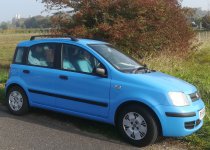Never can recall Citroen Dyane car, but I do recall the 2CV.
One of my acquaintance in the university had bought a brand new 2CV in 1986 or 87. I went his house and he was showing me around the 2CV, and I was not impressed with it at the time. The car looked flimsy and engine sounded like motor bike. I think he said he paid £3500 for it. At the time it was worth a lot more than now I think.
Anyhow, now I wish I went for cars like that. Simple and easy to maintain. They are cars I am after. Not these non sensical computers and engine management lights on the dashboard carry on.
Now, it seems difficult to find simply made cars like that even I tried hard trying to find them in everywhere.
The Dyane was basically the same vehicle but with, in my opinion, a more attractive body. There was also a van version, the Acadiane - I have a "fetish" for vans. I have been keen on drag racing and hot rodding since the '60's and, even now, fantasize about a hot rodded Acadiane - great big rear wheels/tyres, little skinny front ones, Jag independant rear end (chromed of course) a 2.5 litre Daimler V8 in front (in my opinion the "prettiest" engine ever produced!)
The little twin cylinder engine was just about unburstable but, with no oil filter, needed very regular oil changes. It also had it's points hidden behind the cooling fan on the front of the engine. The points (most of the "technicians" now working in garages wouldn't know what to do with them!) needed to be changed every service if you wanted reliability but you had to get the fan off! Unfortunately it was mounted on a taper (like a ball joint so it locked on in the same way) and it is very easy to just snap the tapered nose off the crankshaft. What a lot of people used to do was to cut two of the blades off the fan (one on each side to maintain balance) then you could work through the resulting gap without needing to remove it. There was a special factory puller you could buy, I did, but it didn't really work if the fan was extra tight on it's taper. Now-a-days you can buy an electronic module and just "fit and forget" it!
Another peculiarity was that the front brakes were inboard mounted on the gearbox casing, braking the driveshafts. Earlier cars, mine was one, had drum brakes with the fixed end of the shoes mounted on eccentric pivots (like early Land Rovers - if there are any Landy enthusiasts reading?) not free floating like just about all other brake shoes I've worked with. So, when fitting new shoes, you had to "center" the shoe in relation to the drum by turning the eccentric pivot. It would have been challenging to do on a brake mounted outboard at the at the wheel hub but deep in the engine bay, on the side of the gearbox? Well, the air used to get quite blue at times! If you got it wrong the brakes would squeal horribly! Later models had discs which got over this "problem" all together
These cars also had a very interesting outer driveshaft joint. Instead of a Birfield type CV they had two prop shaft type U/J's back to back in the same boot linked so that each joint shared exactly half of the angular displacement. they were also, very cleverly arranged so that the angular velocity oscillations of the one joint cancelled out the other. (You may know that one of the unwanted properties of a singe U/J is that, it produces a fluctuation - speeding up and slowing down - of the output side of the shaft. This doesn't matter much on a conventional RWD propshaft as the angles involved are slight but on a FWD, where angles can become extreme it can lead to vibration problems and premature wear).
These cars were born in the days when "Citroen" was another way of saying "Different" and nearly everything, from the things talked about above to the suspension, gear change lever (which emerged from the dashboard and was a push/pull and twist device - Renault had one like it on the R4) Ultra thin section 135 tyres! and 3.5 mm brake pipes (with no flex hoses!). You needed a completely different mindset to work on them, but I loved mine dearly.


